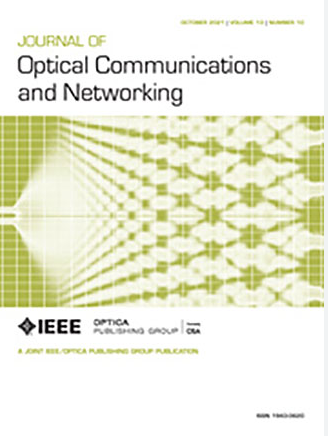物理层安全光网络中窃听感知存活路由
IF 4.3
2区 计算机科学
Q1 COMPUTER SCIENCE, HARDWARE & ARCHITECTURE
引用次数: 0
摘要
随着窃听攻击的不断发生,光网络面临着被窃听的风险。为了防御攻击者的攻击和保护业务传输,物理层安全技术作为一种新的技术出现在光网络中。从生存性的角度来看,保护和恢复方法不仅需要覆盖故障,还需要覆盖安全攻击。因此,本文研究了考虑窃听风险的生存性路由问题。在基于模糊综合评价理论定义共享窃听风险链路组的基础上,设计了允许两种业务互为工作路径和备份路径的共生保护。在共生保护方案的基础上,提出了一种具有两种方案的启发式算法。仿真结果表明,安全优先算法可以将路径风险降低到零,但阻塞了更多的业务;容量优先算法使网络容量提高了约37.072%,但在一条路径中保留了32.335%的高风险链路。本文章由计算机程序翻译,如有差异,请以英文原文为准。
Eavesdropping-aware survivable routing in physical-layer secured optical networks
With tapping attacks gradually occurring, optical networks are facing the risk of eavesdropping. To defend against attackers and protect service transmission, physical-layer security is emerging as a new technique for optical networks. From the survivability perspective, the protection and restoration approaches will need to cover not only failures but also security attacks. Therefore, this work studies the survivable routing problem considering eavesdropping risk. After defining the shared eavesdropping risk link group based on the fuzzy comprehensive evaluation theory, the symbiosis protection that allows two kinds of services to be mutually working paths and backup paths is designed. Following the symbiosis protection scheme, a heuristic algorithm with two schemes is proposed. Simulation results show that the algorithm with security first could lower path risks to zero but block more services, and the algorithm with capacity first improves the network capacity by about 37.072% but keeps 32.335% of links at high risk in a path.
求助全文
通过发布文献求助,成功后即可免费获取论文全文。
去求助
来源期刊
CiteScore
9.40
自引率
16.00%
发文量
104
审稿时长
4 months
期刊介绍:
The scope of the Journal includes advances in the state-of-the-art of optical networking science, technology, and engineering. Both theoretical contributions (including new techniques, concepts, analyses, and economic studies) and practical contributions (including optical networking experiments, prototypes, and new applications) are encouraged. Subareas of interest include the architecture and design of optical networks, optical network survivability and security, software-defined optical networking, elastic optical networks, data and control plane advances, network management related innovation, and optical access networks. Enabling technologies and their applications are suitable topics only if the results are shown to directly impact optical networking beyond simple point-to-point networks.

 求助内容:
求助内容: 应助结果提醒方式:
应助结果提醒方式:


